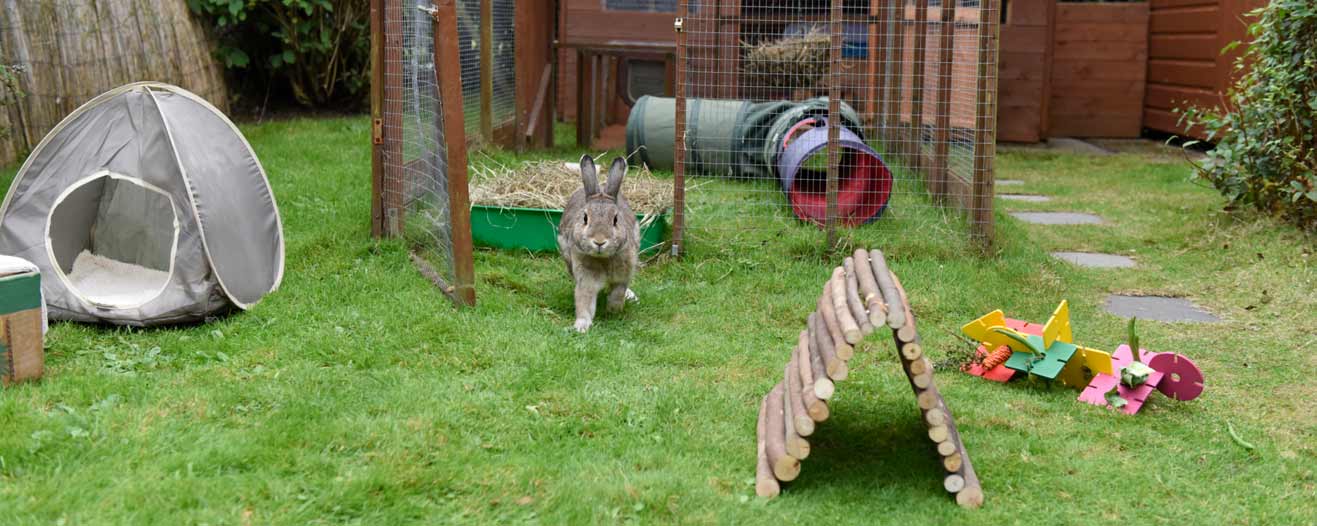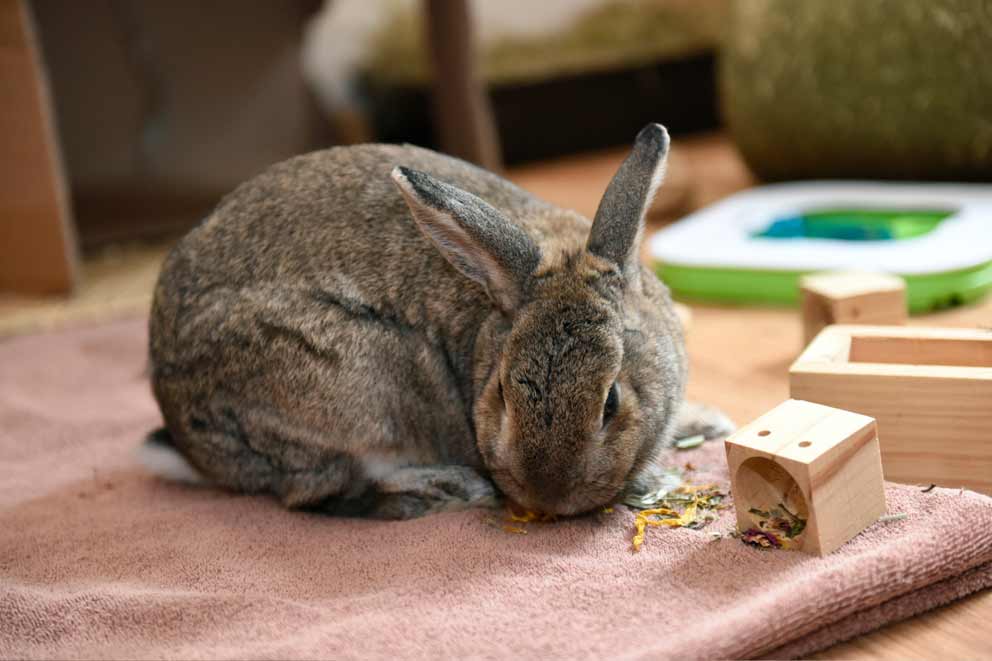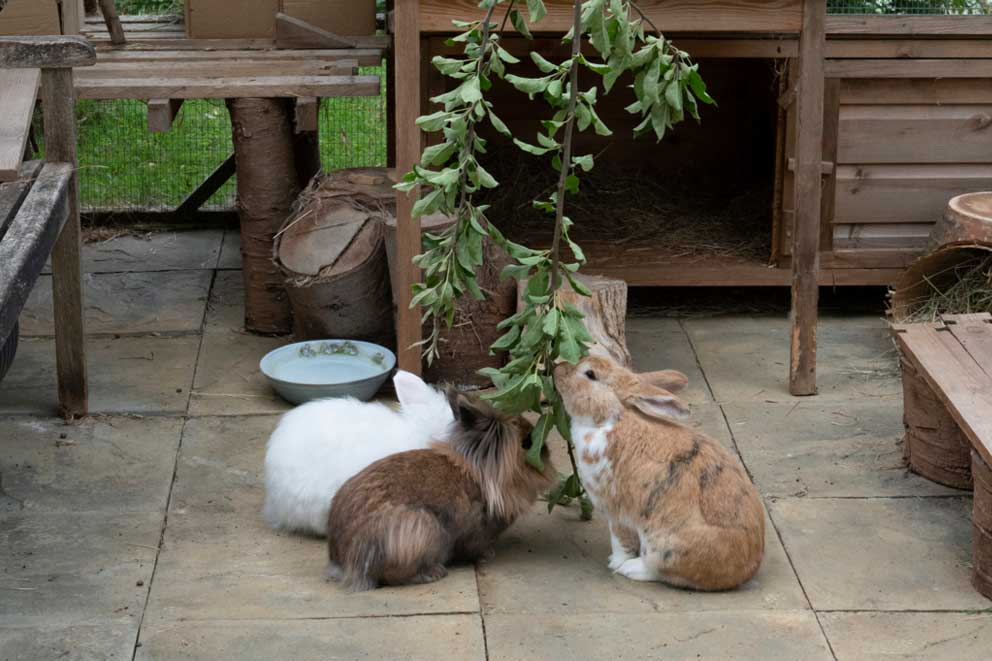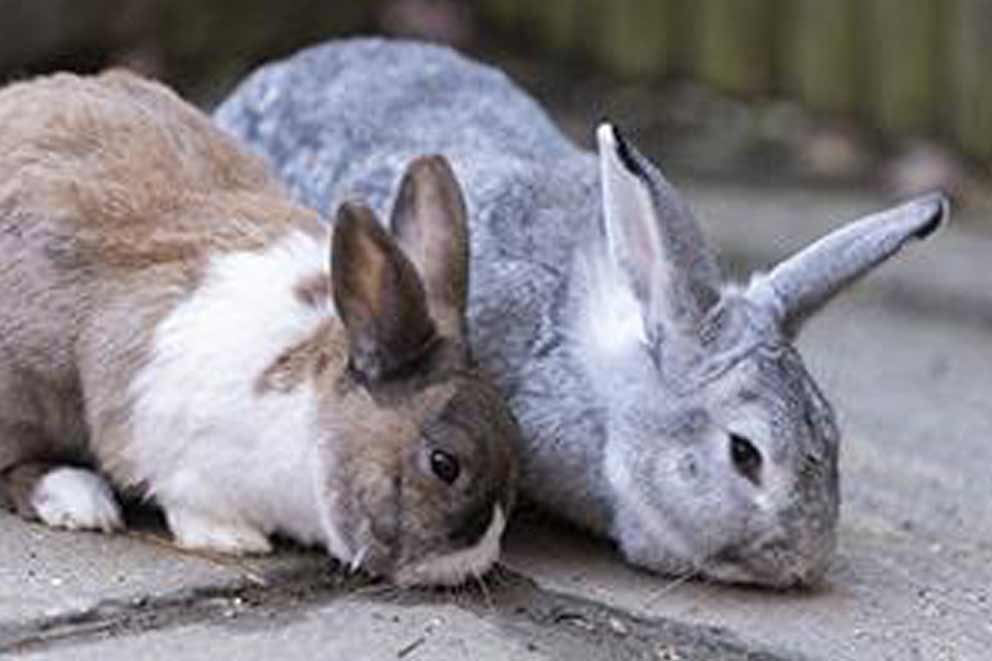A video guide on how to create a rabbit environment
This video is a great introduction to how to create the right rabbit environment for your pet rabbit.
What your rabbit needs for a comfortable home
A secure living space with enough room
Rabbits are active and need to be able to hop, run, jump, dig and stretch out fully when lying down. They need enough room to exercise and stand up fully on their back legs without their ears touching the roof.
For two medium-sized rabbits, we recommend a living space no smaller than 3m x 2m and 1m high – this will include their main shelter and exercise area. A dedicated shed, hut or playhouse with an exercise area attached can make a great home. Rabbits like to have separate areas in their shelter for eating, resting and toileting.
A safe shelter
Provide a secure shelter and an exercise space where they can rest and feel safe. They also need to be protected from predators and extremes of weather and temperature. Add a shade over part of the exercise area if it’s warm and sunny.
The rabbits’ main shelter should be raised above the ground to help deter predators (and stop it getting damp). Any wire mesh should be heavy gauge to stop predators getting in and deter rodents. Fastenings need to be strong.
Rabbits are burrowers, so their housing needs to be designed to stop them digging and escaping – or predators digging their way in. However, we don’t recommend having a wire floor as this can hurt their feet. Their shelter can have a solid (non-slip) floor. In the exercise area, you could dig down, fit a wire bottom to the run below ground level, and then cover it with soil and grass.
A well-ventilated, dry and draught-free home
Living in a draughty, damp, hot, poorly ventilated or dirty environment can cause suffering and illness.
Provide hiding places
Rabbits are a prey species, so need to hide in secure places away from the sight and smell of predators such as dogs, cats, ferrets and birds of prey. Give them constant access to safe hiding places – in their main shelter and the exercise area – so they can escape if they're feeling afraid. Cardboard boxes and tunnels are ideal. They’ll need more than one opening to help the rabbits feel safe.
There should be as many hiding places as there are rabbits, with one extra, if possible. Vary the sizes, so rabbits can hide together or separately – whatever they need at the time. Do bear in mind that rabbits need to move around freely, so don’t fill too much of the space with hiding places (and other objects).
Daily exercise
Rabbits are intelligent, inquisitive and active animals. If they're bored, they may suffer, so they'll need daily exercise to stay fit and healthy. Rabbits are most active in the early morning, late afternoon, and overnight, so ideally they need access to their exercise space during these times. It can be easier for you – and your rabbits – if their exercise space is attached to their home, so they can use it whenever they want.
Toys and stimulation
Think about giving your rabbits a platform to climb on, a sand pit to dig in, a cardboard box to hide in, and lots of other toys, including safe objects to chew and manipulate. Try hanging their food so they need to reach up on their hind legs to eat it, and you could put some hay in a rack or cardboard tubes and empty egg boxes. Encourage foraging by hiding their food in and under things.
Company
Your rabbit needs companionship. Keep them with at least one other friendly, compatible rabbit (though remember that they’ll need space to be together and space to be alone).
Most rabbits enjoy human company too – but take it slowly. Start by getting your rabbits used to your presence and your voice without any physical contact. Later, you can sit on the floor with them and offer some food or a toy and gently stroke them. Let the rabbits come to you. Don't force them to interact with you if they don't want to.
Bedding for warmth
Their bedding should be warm and also safe to eat – dust-free straw or hay is perfect. Add safe, absorbent materials below the hay. These could include newspaper and dust-free (non-cedar) wood shavings.
Suitable toilet area
Rabbits need regular (ideally constant) access to a suitable toilet area. If you provide litter trays, use newspaper, hay or straw, shredded paper and/or paper-based non-clumping, non-expanding cat litter. Their toilet areas should be separate from sleeping areas.
A daily clean
The toilet areas need cleaning every day. The whole enclosure should be cleaned around once a week. You may need to clean more regularly, so keep an eye on the amount of soiling. The more rabbits you keep together, the more often you'll need to clean out the entire enclosure.
Cleaning can be stressful for the rabbits. We suggest putting a small amount of the used bedding back in, so there is a familiar smell. Check that the cleaning products are non-toxic and make sure the shelter is dry before putting the rabbits back.
Hazard-free space
Rabbits are inquisitive and will chew. Make sure their housing is made from chew-resistant materials and that any waterproofing or preservative treatments are non-toxic to rabbits. Keep their space clear of hazards and make sure there’s nothing dangerous nearby that they could try to reach.
Make sure all materials are non-toxic and have smooth, rounded edges. Regularly inspect items for damage or ways they could injure your rabbit. Repair, replace or get rid of items that are damaged or dangerous.
Going away
If you’re going away, try to find someone who can look after your rabbits in your own home, for familiarity. If boarding, keep pairs or groups of rabbits together and take familiar items such as their toys.
Read our advice on transporting rabbits.




